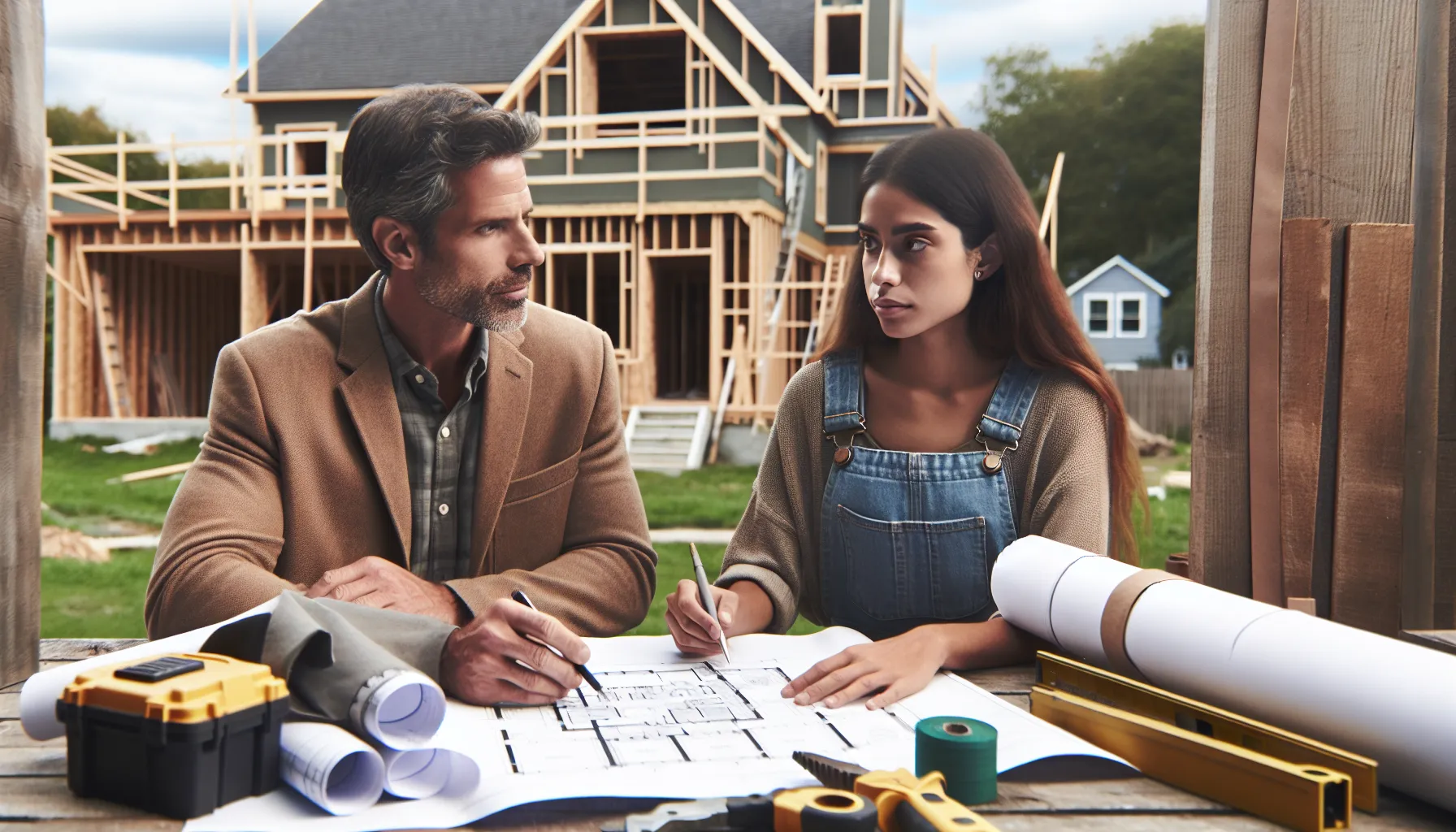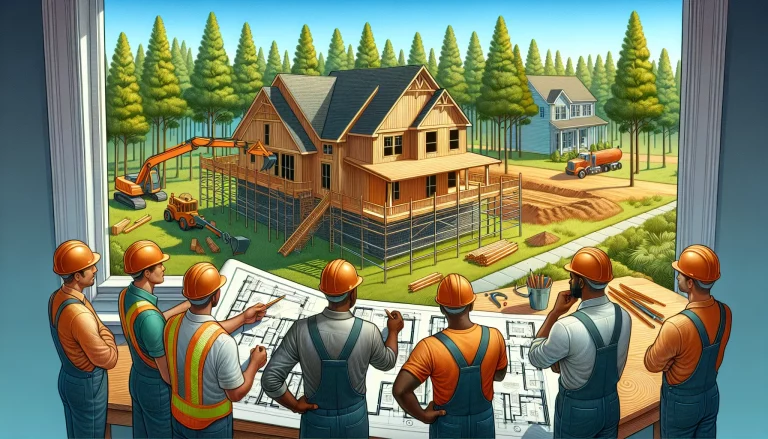Key Takeaways
- Comprehensive Guide: Building a house involves 35 critical steps, from selecting land to final inspections, ensuring an organized approach to home construction.
- Budgeting Essentials: Defining a clear budget is crucial. It should encompass land costs, permits, materials, and unexpected expenses to prevent overspending.
- Location Matters: Choosing the right location affects your home’s value and livability. Consider access to schools, safety, and local zoning laws during your selection process.
- Design and Permits: Collaborating with architects and securing necessary permits ensures your design aligns with safety standards and local regulations, laying a strong foundation for the build.
- Construction Phases: Key construction stages include site preparation, laying the foundation, and installation of essential systems like plumbing and electrical, all requiring careful coordination and inspection.
- Post-Construction Steps: Final inspections, landscaping, and addressing minor repairs are essential to ensuring your new home is safe, inviting, and ready for living.
Building a house is an exciting journey that many of us dream about. But with so many steps involved, it can feel overwhelming. From selecting the perfect plot of land to putting the finishing touches on your new home, understanding the entire process is crucial. That’s why we’ve created this comprehensive guide outlining the 35 essential steps to building a house.
Overview of The 35 Steps to Building a House
Building a house involves a methodical approach, consisting of 35 distinct steps that guide us from inception to completion. Each step plays a crucial role in ensuring the project meets our expectations for quality, safety, and livability. We begin with selecting the right plot of land, a foundational decision that influences every subsequent action. Next, we navigate zoning laws and permits, making sure to comply with all local regulations.
As we progress through the construction timeline, we address essential elements such as hiring qualified contractors, managing budgets, and selecting materials. Detailed planning becomes vital, particularly during the design phase, where we define our vision and functional needs. Once construction begins, we focus on the structural integrity of the home, ensuring each stage aligns with industry standards and our project parameters.
Throughout the journey, we remain attentive to inspections and approvals, as these checkpoints ensure compliance and quality control. After completing the framework and systems like plumbing and electrical, we shift attention to interior finishes that personalize our space. The final steps involve ensuring proper landscaping and final inspections before moving in.
Understanding and following these 35 steps enables us to build not just a house, but a home that meets our long-term needs and aspirations. Each action we take contributes to the overall success of our project, leading us to the rewarding moment when we finally turn the key to our new residence.
Planning Your Build

Planning our build involves careful consideration of various critical factors, setting the foundation for a successful home construction journey. We must prioritize defining our budget and choosing the right location to create a well-thought-out blueprint for our future home.
Defining Your Budget
Defining our budget serves as the cornerstone of the entire building process. Establishing a clear budget helps us allocate resources effectively and prioritize essential features. We should include costs such as land acquisition, permits, materials, labor, and interior finishes. It’s vital to also account for unexpected expenses, typically around 10-20% of the total budget, which cushions us against unforeseen challenges. By performing due diligence on each expense, we create a realistic financial plan that lets us avoid overspending and ensures the completion of our dream home. Open-ended questions about our lifestyle needs, such as how long we plan to stay in the house or what features truly enhance our living experience, guide us in making informed decisions.
Choosing the Right Location
Choosing the right location profoundly influences our home’s long-term value and livability. We must consider factors such as proximity to schools, employment centers, and amenities while assessing the neighborhood’s safety. Researching local zoning laws helps us understand potential restrictions on property development, which can affect future plans. We should also explore the area’s housing market trends, as purchasing in a growing community can lead to valuable appreciation. Reflecting on our personal lifestyle preferences, including travel needs and recreational opportunities, allows us to select a location that aligns with our vision for home and community. Ultimately, thoughtful evaluation of these aspects ensures a harmonious fit between our living space and broader surroundings.
Design and Permits

Designing a home and obtaining necessary permits are crucial steps in the construction process. These stages ensure that our vision aligns with local regulations and safety standards, setting the foundation for a successful build.
Working with Architects and Designers
Working with architects and designers guides us in translating our ideas into a functional home plan. Architects analyze our needs and create designs that optimize our space while complying with building codes. Designers focus on aesthetics and interior layouts, ensuring our home reflects our personal tastes. Collaboration during this phase leads to a comprehensive set of blueprints, essential for the next steps in construction. For instance, our architect might suggest energy-efficient materials, which can reduce long-term costs and environmental impact. Engaging professionals can enhance not only the design quality but also the overall efficiency of the building process.
Securing Necessary Permits
Securing necessary permits is a vital part of the home-building process. Each locality has specific regulations that dictate what is permissible. We first identify the types of permits required, such as zoning permits, building permits, and occupancy permits, depending on our project’s scope. The application process often involves submitting detailed plans to local authorities, who review them for compliance with codes and regulations. For example, a building permit may require structural calculations and environmental assessments to ensure safety and sustainability. Failing to obtain the proper permits can result in significant delays or even penalties, underscoring the need for thorough research and adherence to local guidelines.
Construction Process
The construction process involves several vital phases that turn our vision of a new home into reality. Each stage requires careful coordination, skilled labor, and adherence to regulations.
Preparing the Site
Preparing the site forms the foundation for our future home. This stage includes clearing debris, leveling land, and ensuring proper drainage. We often need to grade the land to create a solid base and alleviate potential water issues. Additionally, marking the boundaries helps prevent disputes with neighbors and establishes the house layout. An important step is obtaining a survey to confirm that we’re building within our property lines and local zoning laws.
Foundation and Framing
Foundation and framing lay the structural base of our house. The process begins with digging trenches for footings and pouring concrete for the foundation. Once the foundation sets, framing starts using wood or steel to form the house’s skeleton. This process includes erecting walls, joists, and roof trusses, determining the home’s layout and integration of space. Timely inspections during this phase ensure compliance with building codes and maintain the project’s integrity.
Electrical and Plumbing Installation
Electrical and plumbing installation creates essential systems for our daily lives. Professional electricians install wiring, outlets, and fixtures, while plumbers lay piping for water supply and drainage. We must ensure installations meet safety standards and local regulations. The timing of this phase is crucial; completing these systems before insulation and drywall minimizes disruption. Inspectors often review these installations to verify compliance and functionality.
Installing Finishes
Installing finishes personalizes our home and enhances its livability. This stage includes drywall installation, painting, flooring, and cabinetry. We select materials that reflect our style preferences and budget, impacting the overall aesthetics of the living space. Proper installation of fixtures such as lights and appliances transforms the house into a functional home. Final inspections check that every detail aligns with our expectations and safety standards, paving the way for moving in.
Post-Construction Considerations
Post-construction considerations play a vital role in the overall satisfaction and functionality of our new home. Conducting necessary tasks following the building phase ensures we create an inviting and suitable environment. Here’s a closer look at crucial factors after construction is complete.
Landscaping and Exterior Work
Landscaping and exterior work significantly enhance our property’s curb appeal and livability. First, we assess our yard’s layout and design, considering plant selection, hardscaping elements, and outdoor features such as patios or walkways. For instance, choosing native plants reduces water consumption and maintenance needs.
Moreover, installing drainage solutions prevents water accumulation and protects our home’s foundation. We should also consider outdoor lighting for safety and aesthetics. Using LED fixtures not only saves energy but also promotes security after sunset. Completing our landscaping and exterior work creates a welcoming atmosphere that complements our home’s architecture.
Final Inspections and Handover
Final inspections and handover activities are essential to validate our new home’s readiness. We should coordinate with our contractor to schedule comprehensive inspections, covering structural elements, plumbing, and electrical systems, ensuring everything adheres to building codes. For example, hiring a certified inspector can provide an unbiased evaluation.
After inspections, we obtain a certificate of occupancy, confirming our home meets all legal standards. This step protects us from future compliance issues. Finally, a thorough walkthrough with our contractor allows us to address any concerns or minor repairs before moving in. Securing these final assessments ensures we enter our new home with confidence, emphasizing its safety and livability.
Conclusion
Building our dream home is an incredible journey filled with opportunities for creativity and personal expression. By following the 35 steps outlined in this guide, we can navigate the complexities of construction with confidence.
Each phase not only contributes to the structural integrity of our home but also reflects our unique vision and lifestyle. As we embrace this process, we’ll ensure that every decision aligns with our long-term goals and aspirations.
Ultimately, the effort we invest in planning and executing these steps will lead us to the rewarding moment of stepping into a space that truly feels like home. Let’s embark on this exciting adventure together, turning our dreams into reality with each carefully considered step.
Frequently Asked Questions
What are the first steps in building a house?
Building a house starts with selecting the right plot of land. This includes evaluating zoning laws, securing permits, and understanding local regulations. These foundational steps are crucial for setting the stage for a smooth construction process.
How many steps are involved in the house-building process?
There are 35 essential steps in the house-building process. Each step is designed to ensure that the construction meets quality, safety, and livability standards from inception to completion.
Why is budget planning important when building a house?
Budget planning is critical as it serves as the cornerstone of the project. It allows you to allocate resources wisely and prepare for unexpected expenses, ensuring the project stays on track financially.
What should I consider when choosing a location for my new home?
When choosing a location, consider factors such as proximity to amenities, neighborhood safety, and local housing market trends. A well-chosen location enhances the livability and long-term value of your home.
Who should I hire during the house-building process?
It’s important to hire qualified contractors, architects, and designers. Their expertise ensures that the construction adheres to safety standards and building codes while bringing your vision to life through functional home plans.
What are essential systems to install during construction?
Key systems include electrical and plumbing. These installations must meet safety standards and local regulations and should be done at the appropriate time to minimize disruption during the construction process.
How do I ensure my new home passes final inspections?
To ensure your home passes final inspections, adhere to building codes and safety standards throughout the construction process. Regular inspections during construction can help identify issues before the final walkthrough.
What is involved in the post-construction phase?
The post-construction phase includes landscaping and exterior work to enhance curb appeal. It also involves final inspections and handover activities to ensure everything is completed to standard before moving in.






